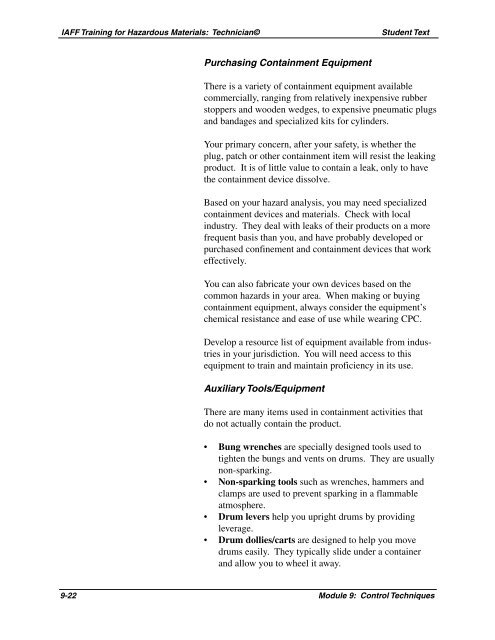Module 9: Control Techniques - International Association of Fire ...
Module 9: Control Techniques - International Association of Fire ...
Module 9: Control Techniques - International Association of Fire ...
You also want an ePaper? Increase the reach of your titles
YUMPU automatically turns print PDFs into web optimized ePapers that Google loves.
IAFF Training for Hazardous Materials: Technician©<br />
Student Text<br />
Purchasing Containment Equipment<br />
There is a variety <strong>of</strong> containment equipment available<br />
commercially, ranging from relatively inexpensive rubber<br />
stoppers and wooden wedges, to expensive pneumatic plugs<br />
and bandages and specialized kits for cylinders.<br />
Your primary concern, after your safety, is whether the<br />
plug, patch or other containment item will resist the leaking<br />
product. It is <strong>of</strong> little value to contain a leak, only to have<br />
the containment device dissolve.<br />
Based on your hazard analysis, you may need specialized<br />
containment devices and materials. Check with local<br />
industry. They deal with leaks <strong>of</strong> their products on a more<br />
frequent basis than you, and have probably developed or<br />
purchased confinement and containment devices that work<br />
effectively.<br />
You can also fabricate your own devices based on the<br />
common hazards in your area. When making or buying<br />
containment equipment, always consider the equipment’s<br />
chemical resistance and ease <strong>of</strong> use while wearing CPC.<br />
Develop a resource list <strong>of</strong> equipment available from industries<br />
in your jurisdiction. You will need access to this<br />
equipment to train and maintain pr<strong>of</strong>iciency in its use.<br />
Auxiliary Tools/Equipment<br />
There are many items used in containment activities that<br />
do not actually contain the product.<br />
• Bung wrenches are specially designed tools used to<br />
tighten the bungs and vents on drums. They are usually<br />
non-sparking.<br />
• Non-sparking tools such as wrenches, hammers and<br />
clamps are used to prevent sparking in a flammable<br />
atmosphere.<br />
• Drum levers help you upright drums by providing<br />
leverage.<br />
• Drum dollies/carts are designed to help you move<br />
drums easily. They typically slide under a container<br />
and allow you to wheel it away.<br />
9-22 <strong>Module</strong> 9: <strong>Control</strong> <strong>Techniques</strong>
















